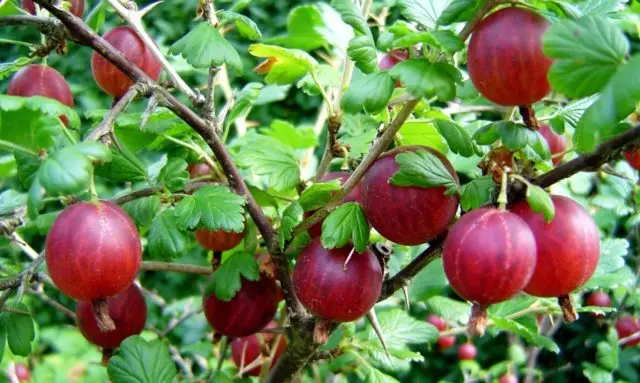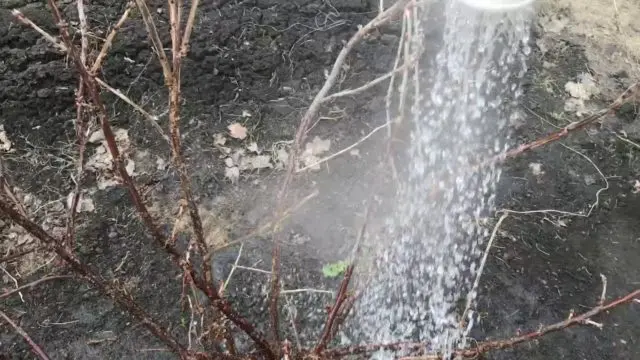Contents
Caring for gooseberries in the spring has its own characteristics, on which not only the quality of shrub growth, but also the amount of the crop largely depends. Therefore, it is important for beginners in gardening to know about certain rules for caring for a plant.
How to care for gooseberries in spring after winter
Many owners of garden plantations believe that caring for gooseberries is easy – just harvest on time and occasionally cut branches. In fact, the shrub needs more serious care, especially in spring, when its vegetative process starts.

Measures for the care of gooseberries in the spring consist of the following items:
- Removal of covering material and mulch layer.
- Shrub pruning.
- Loosening the soil and removing weeds.
- Watering.
- Introduction of mulch.
- Fertilizer.
- Preventive measures aimed at the destruction of pests.
- Transfer.
Shelter removal
The start of work falls on the period when the snow layer will come down, and the air temperature will not fall below 5 degrees Celsius even at night. Usually such a period in the middle lane falls on the second half of April.
First of all, it is necessary to remove the shelter from the bush, which protected it from winter frosts. In the northern regions, fruit bushes are insulated with wooden boxes, which are recommended to be removed already at a temperature of 2-3 degrees Celsius.
In the middle lane, gooseberry insulation is carried out with a layer of mulch, which must be carefully raked out with a rake. Otherwise, a fungus may begin to develop under the shrub, and various pests will attack it. Removing the cover will also allow the soil to warm up faster, which will encourage the plant to start growing.
Cleaning the root zone
The root system must also be cleaned of various litter, including last year’s foliage. This will also protect the shrub from pests and the occurrence of fungal and infectious diseases. All garbage must be taken out of the site, and ideally – burned.
When examining a bush, it is necessary to pay attention to the condition of the shoots in order to timely identify frozen and broken bushes. If damaged parts of the culture are found, they are removed by cutting so that the plant does not waste vitality on dead shoots.

How to care for gooseberries in spring
Caring for gooseberries in the spring after winter is the key to a high harvest in the fall. Therefore, it is necessary to carefully consider this issue and follow all recommendations for growing a plant.
Watering, feeding
When the snow masses completely melt and dry weather sets in, the shrub should continue to receive moisture. Therefore, it should be watered occasionally, focusing on the presence of precipitation and dryness of the soil. This should be done with a little warm water, at least 1 time in 10 days.
If the spring is rainy, then the gooseberries do not need additional watering until the onset of steadily hot weather.
Another important event for the care of gooseberries in early spring is feeding the bush.
- During the period of swelling of the kidneys, the introduction of nitrogen-containing preparations will help. This contributes to the growth of green mass.
- Before flowering, the addition of potassium and phosphorus is necessary.
- After harvesting, re-fertilizing with phosphorus-containing preparations and potassium is required.
Weeding, loosening the soil
Caring for gooseberries in the spring in the country also means thorough weeding. This event contributes to:
- the supply of oxygen to the roots;
- unimpeded receipt of the bush of nutrition and moisture.
After the weeds are removed, it is necessary to carefully loosen the soil. This must be done with extreme caution, since the gooseberry root system is superficial and can be damaged. Therefore, when loosening in the spring, special choppers or improvised means are used to raise the ground with a layer of no more than 5 cm.
Mulching the root zone
Gooseberries after winter require special care, which, among other things, involves the introduction of mulch in the spring. It is needed so that weeds do not grow, and moisture does not evaporate so quickly.
The following materials can also be used as mulch in spring:
- bumps;
- sawdust;
- straw;
- compost;
- humus;
- peat.
Preventive treatments
Spring gooseberry care includes treatment for pests and diseases. In the spring, as a rule, boiling water is poured over the shrub, but such an event is not always enough. Therefore, the bush is sprayed with special preparations intended for crops of this species.

How to care for gooseberry bushes in summer
Caring for gooseberries in the summer consists in irrigating, applying phosphorus and potash fertilizers.
- Watering is necessary for gooseberries only in case of dry weather and during the flowering period.
- Fertilizers are applied at the time of budding and after harvest.
- The soil is loosened once every two weeks, at the same time weeds are removed.
The most important thing is to take care of the gooseberries in July, when flowering and fruit set begin. During this period, it is necessary to inspect the shrub for the presence of pests and diseases, even if preventive treatment was carried out in the spring.
Gardening tips for caring for gooseberry bushes in spring
The advice of experienced gardeners will help to properly care for gooseberries, which can save beginners from a number of the most common mistakes:
- It is important not to miss the time to start processing the fruit shrub in the spring. You can start work after the air temperature does not fall below 5 degrees Celsius.
- Leaves and mulch that are left over from last year should be removed from the site. During the winter period, various pathogenic fungi could develop in them, which can spread to other plantations. Therefore, in the spring, all garbage and rubbish is taken out of the site and burned or buried in the ground.
- Pruning should be done before sap flow begins in the gooseberries and buds form.
- Pruning is essential, as weak branches are a good target for fungal and viral diseases. If you feel sorry for the gooseberry bushes in the spring, then in the fall you can not get a lot of berries.
- It is necessary to process the plant after pruning and pouring the bush with boiling water. Otherwise, the gooseberry will not receive protection from pests and diseases.
- Gooseberries need top dressing not only in autumn, but also in spring. The quality of the crop depends on how well the soil is fertilized.
- Every fertilizer has its own time. Leaves need nitrogen. Therefore, in the spring you need to feed the gooseberries with it. Then the plant needs phosphorus and potassium, which must be applied twice more per season.
- Watering is important for gooseberries even in spring. This is especially true during periods when the weather is dry and warm. Therefore, you should not rely on moisture reserves in the ground, but water the bush at least once every 1-10 days.
- Gooseberry care in spring and summer consists of watering and removing weeds. Therefore, do not forget that even such an unpretentious plant will bear fruit and grow better on moist and clean soil.
- Timely loosening of the soil allows the gooseberry to be enriched with oxygen and nutrients. If the soil is covered with a dense crust, then the gooseberries will grow small and rather sour.
By following these tips, you can lay a reliable “foundation” for a rich harvest in the spring.
Conclusion
Caring for gooseberries in the spring is no different from caring for currants or raspberries. The main thing is to protect the plant from pests and diseases, remove diseased shoots in a timely manner, fertilize and follow the watering schedule. Responsible care for gooseberries in the spring is the key to good growth.









